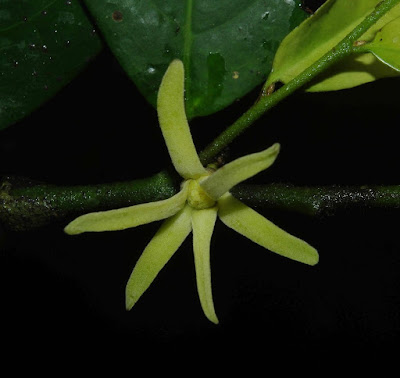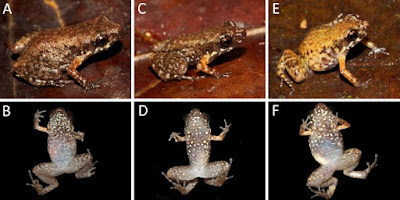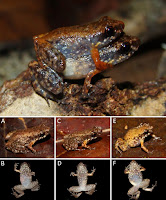[Most Recent Entries] [Calendar View]
Tuesday, December 18th, 2018
| Time | Event | ||||
| 11:05a | [Botany • 2019] Pre‐Pleistocene Origin of Phylogeographical Breaks in African Rain Forest Trees: New Insights from Greenwayodendron (Annonaceae) Phylogenomics
Abstract Aim: Palaeoecological records indicate that Pleistocene glaciations affected the African rain forest, probably causing its fragmentation, which could explain phylogeographical breaks documented in many tree species. This refuge hypothesis was further tested through species distribution models, hindcasting persistence during the Last Glacial Maximum. However, previous studies failed to estimate with sufficient precision the divergence time between phylogeographical entities to confirm their Pleistocene origin. Developing genomic tools on a representative tree of mature rain forests, we test if parapatric genetic clusters documented in widespread tree species can be interpreted as the legacy of past population fragmentation during the last glacial period(s). Location: Tropical Africa, Guineo‐Congolian forests. Taxon: Greenwayodendron (Annonaceae). Methods: To further test the Pleistocene refuge hypothesis by molecular dating, we sequenced the plastome of 145 individuals of the shade‐tolerant rain forest tree Greenwayodendron suaveolens and congeneric species, and genotyped the same samples using nuclear microsatellites to identify genetic clusters. Results: Five plastid phylogroups of G. suaveolens occur in parapatry throughout Central Africa, following a spatial pattern generally congruent with genetic clusters. Four of them diverged 3.5–4.5 Ma, whereas the fifth one, located in the Cameroon volcanic line (CVL), diverged 8.3 Ma, in the range of divergence times between Greenwayodendron species, highlighting the key role of the CVL in hosting ancient lineages. Within phylogroups, most nodes were dated from 0.9 to 3.2 Myr and a correlation between haplotype divergence and spatial distance was still perceptible, indicating a slow population dynamic. Main conclusions: The phylogeographical structures of Central African trees probably established during the Pliocene or early Pleistocene, and while they might have been reinforced during subsequent glacial–interglacial cycles, interglacial phases did not lead to genetic homogenization. Therefore, interpreting phylogeographical patterns of African trees must account for a much deeper past than previously assumed, and cannot be limited to the last glacial period. Keywords: African rain forests, evolutionary history, Greenwayodendron, High‐throughput sequencing, molecular dating, nuclear microsatellites, phylogeography, plastome captures, Pleistocene glaciations CONCLUSIONS: The well‐resolved plastome phylogeny of Greenwayodendron species challenges the accepted view of Central African forest historical dynamics by showing that phylogeographical patterns of mature forest trees can have a very ancient origin, pre‐dating the Pleistocene. Our results call for a reassessment of the reference time‐scale traditionally used to interpret phylogeographical patterns in African rain forest trees, earlier than the last glacial cycle. The long generation time of shade‐tolerant tree species, their limited dispersal capacity and their incapacity to colonize open habitats probably explain their slow spatial dynamics, which in turn induces genetic signatures of very ancient historical or biogeographical events. Jérémy Migliore, Esra Kaymak, Cédric Mariac, Thomas L. P. Couvreur, Brandet‐Junior Lissambou, Rosalía Piñeiro and Olivier J. Hardy. 2019. Pre‐Pleistocene Origin of Phylogeographical Breaks in African Rain Forest Trees: New Insights from Greenwayodendron (Annonaceae) Phylogenomics. Journal of Biogeography. DOI: 10.1111/jbi.13476 | ||||
| 12:20p | [Herpetology • 2018] Phyzelaphryne nimio • A New Species of Phyzelaphryne Heyer, 1977 (Anura: Eleutherodactylidae) from the Japurá River Basin, northwestern Brazilian Amazonia, with A Discussion of the Diversity and Distribution of the Genus
Abstract We describe and name the second species of Phyzelaphryne (Brachycephaloidea, Eleutherodactylidae), from northwestern Brazilian Amazonia. Phyzelaphryne nimio sp. nov. is distinguished from its only congener, Phyzelaphryne miriamae, by its smaller body size and the anatomy of the carpal and metacarpal regions, with relatively larger (sometimes fused) supernumerary carpal and metacarpal tubercles. Molecular phylogenetic analyses based on fragments of the mitochondrial genes 16S rRNA and COI suggest that the currently known distribution of the species is restricted to its type locality and other areas within Estação Ecológica Juami-Japurá, state of Amazonas, Brazil. Based on molecular, morphological and bioacoustic evidence, we assigned other specimens recently collected in Parque Nacional do Jaú, state of Amazonas, Brazil, to P. miriamae, extending the species’ known geographic distribution north of the Amazon River. Keywords: Amphibia, Amazonia, Brazil, conservation units, DNA barcoding, morphology, Phyzelaphryninae, Terrarana
Pedro Ivo Simões, João Carlos Lopes Costa, Fernando J.M. Rojas-Runjaic, Giussepe Gagliardi-Urrutia, Marcelo José Sturaro, Pedro L.V. Peloso and Santiago Castroviejo-Fisher. 2018. A New Species of Phyzelaphryne Heyer, 1977 (Anura: Eleutherodactylidae) from the Japurá River Basin, with A Discussion of the Diversity and Distribution of the Genus. Zootaxa. 4532(2); 203–230. DOI: 10.11646/zootaxa.4532.2.2 |
| << Previous Day |
2018/12/18 [Calendar] |
Next Day >> |









